The train began slowing on the last straight stretch for the tight curve
followed by the run over the gorge at Kuskulana. The cantilever steel
bridge was built to last. No vibration could ever be felt on the train
when it was over the steel part of the bridge. But the wooden trestle
approaches shook as the train reached it. The far approach again
trembled as the short consist left the steel section for the east
trestle approach. It was 237 feet straight down at center, providing a
view which, over the years, would cause many a passenger to gasp. The
train slowed to the customary ten miles an hour. Birch and Jackling and
their two assistants had a good view of the gorge from the high point of
the steel bridge.
|
Various construction views of the Kuskulana
Bridge: |
|
|
Top row is from the UAF AK & Polar Regions
photo archives. The sepia-ones are from the Van Cleve photo
collection.
| |
|
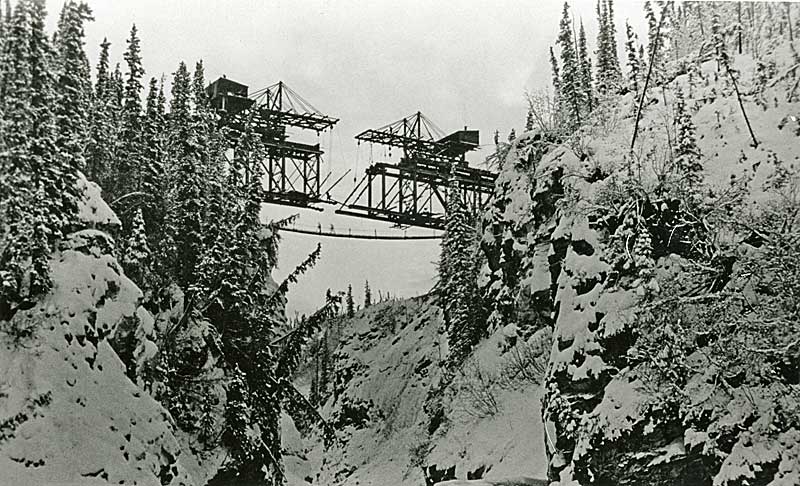 | |
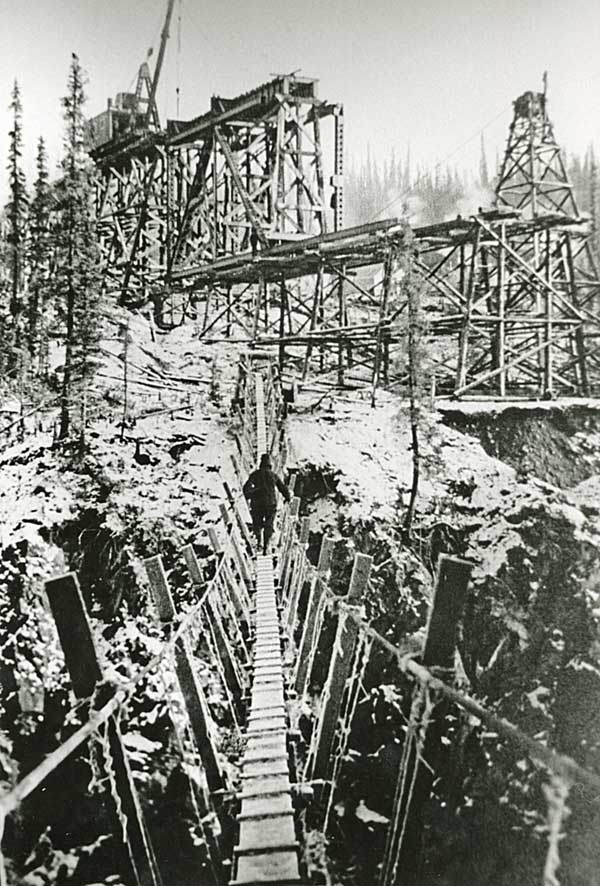 | |
| | | | |
|
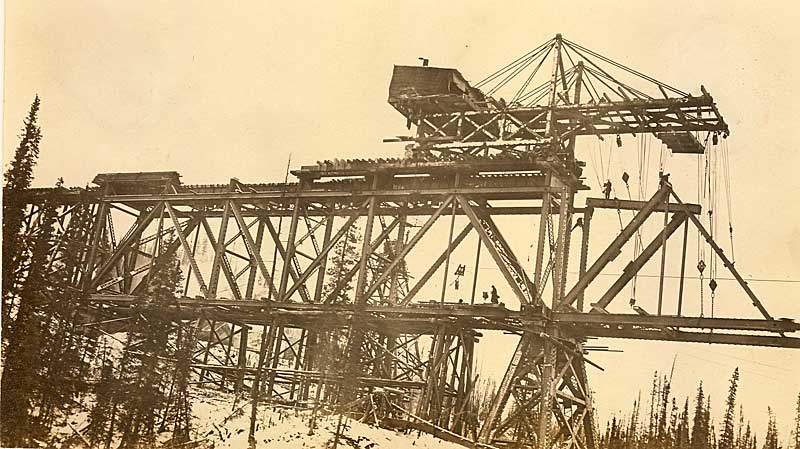 | |
 | |
| | | | |
|
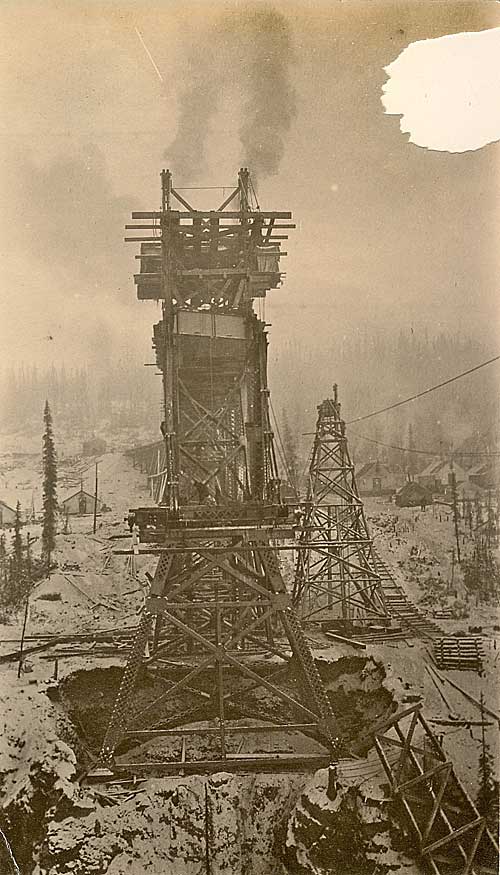
| |

| |
| | | | |
|
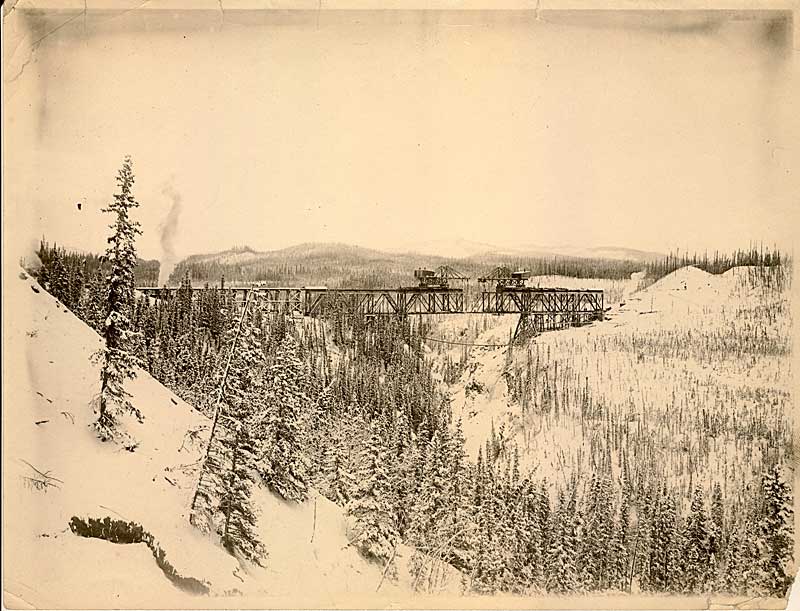
| |
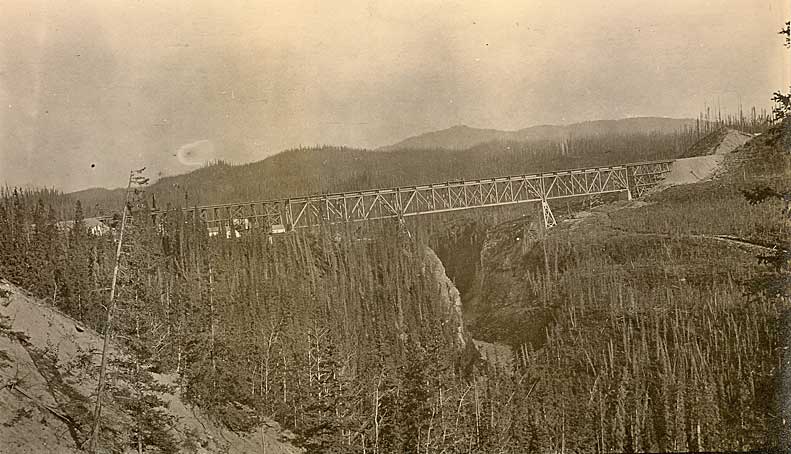 | |
| | | | |
“One of the our overriding considerations in closing the Kennecott mine
system will be the amount of maintenance we can defer on this railroad.
This bridge may be here a long time. It was certainly designed to last a
good century. But most of the line is still highly temporary and
expensive to maintain. At this late stage of mine development, we don’t
want to find ourselves rebuilding much of this railroad only to close it
a year or two later. We want to run the line as long as possible with
all our old original equipment and keep it running economically until it
is ready to fall apart. This more than anything else may ultimately
determine when we shut the whole works down.”
Jackling was surprised by this.
“I thought that the plan called for extending the Cordova mainline on to
Fairbanks.”
“Sorry I never brought you up on that, Dan. I forgot that you’re new to
this Kennecott Alaska business. Years ago we gave up on that possibility
when it became apparent just how hostile the territorial government is
to our operation. Once the federal government began building the
railroad out of Seward that possibility was eliminated. We will pull out
of the railroad business in Alaska when we abandon our mines. There is
nowhere near enough other business to support this railroad without our
mines.”
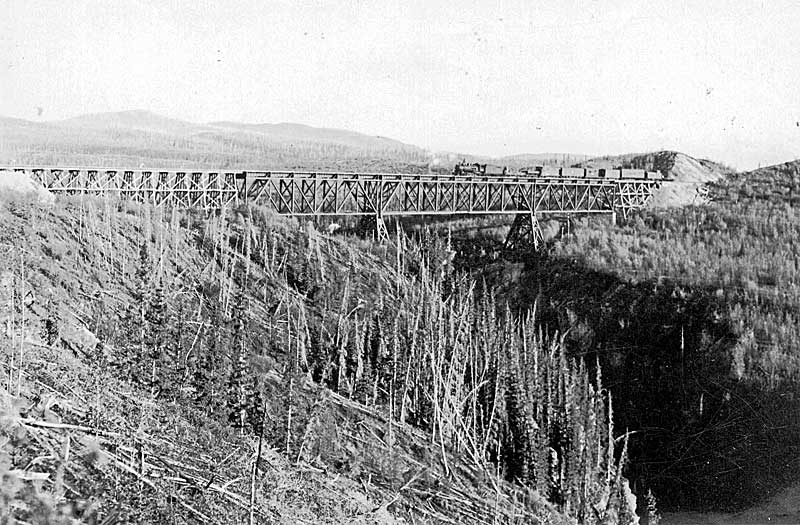
|
Kuskulana
Gorge & steel bridge --Laurie Nyman photo |
Dan looked out the large window toward the distant Chugach Range on his
right. To the north he could now get a close view of the treeless
Crystalline Mountains. There was nothing unusual about them if you lived
in Alaska. But elsewhere they would be considered most remarkable.
“What an irretrievable loss for most every adventurous wandering soul.
This is scenery which everyone should see at least once in their
lifetime.”
“We went to so much trouble to carve out this route, Dan. Nature will
reclaim our millions of dollars worth of work very quickly. I wonder
what people who visit the area by some other means will be thinking
sixty years from now -- those people who happen to look down on some
piece of overgrown right of way , and spot our old rails way out here.
“We’ll leave behind all our old station buildings, but they’re all of
wood frame construction. They will all succumb to the elements, or be
destroyed by salvagers, vandals and all the other human parasites which
always exist in the shadowy background of humanity.
“And the wooden trestles. There are so many of them. We’ll see the grand
daddy of them all soon. The Gilahina is coming up. These are all going
to undoubtedly begin falling in once we abandon the area. We are
continually rebuilding parts of them. They are the main reason we have
to consider our timing carefully. At one time on the Cordova main line
we were going to replace almost all of them with permanent steel ones.
The rest of them we were going to fill in. We have already filled in
many miles of low-lying trestles. But the large ones like the Gilahina
or the O’Brien Creek trestle will just have to be held together by
whatever means we can muster until there is nothing further we can do
with them. We built the system to last only ten years, you know. Now
it’s been thirteen. That’s about enough.”
Tom Bell came out with the coffee. Stephen smiled and accepted, as did
Jackling. The company aides remained silent as they listened to this
long speech. Dermot was getting bored.
| Stephen’s been at this
business too long. He’s talking like an old man. He ought to
think about retiring. | |
“Who in the not so distant future could ever possibly conceive of what
it really took to build this railroad and mine system into what we now
have? Will those distant travelers even care? When we leave, mark my
words, only the Indians and a few very hardy or very foolish whites will
remain behind. This place will rapidly revert to the wilderness we found
here only a few years ago. Little will ultimately remain to remind those
people of the grandeur of what once was, what still is today.
“None of us will be alive then. No one will remember who we were. If
anything, we’ll probably only exist in some school kids’ textbooks as
greedy capitalist monsters with no stake in the future of this
territory.
“We have done so much and come so far. My entire adult life with all the
luxuries and power I now enjoy can be directly attributable to this one
area. Many came here to follow their dreams. I was one of them. The two
of us in this car, representing the absolute pinnacle of industrial
American power, will become insignificant in the face of Mother Nature.
She will eventually overwhelm everything we have accomplished in this
territory.”
The train began slowing as it approached the large curved trestle
crossing the small Gilahina River ninety-four feet below. This was the
largest and tallest wooden bridge in the system--a particularly
outstanding example of the uniqueness of the CRNW Railway. The mammoth
structure was completed in ten days in the middle of winter when
temperatures ran no warmer than thirty below and even dipped to sixty
below for a time. Nothing quite like this special bridge would ever be
built in this manner again.
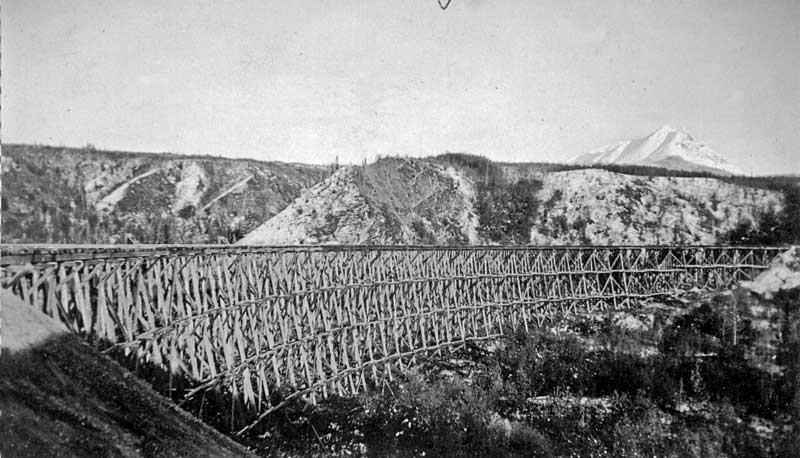
|
Gilahina trestle --Laurie Nyman
collection |
A CRNW passenger train crosses the Gilahina
trestle --Skinner Foundation, PCA 44-2-153, Ak State Library |
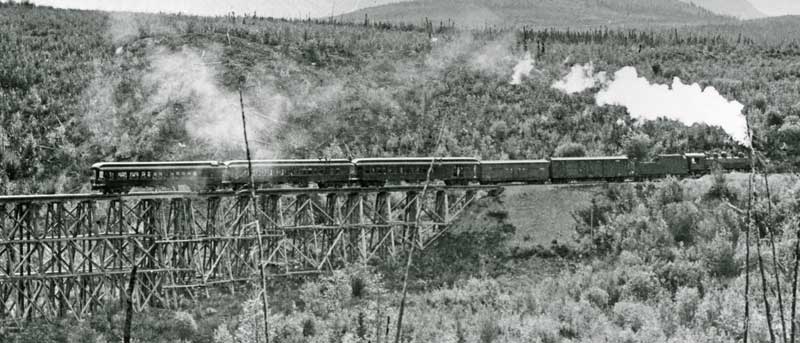
|
In the rear is observation car # 100. The
locomotive is one the the new 70-series. |
”We may both be part of the so-called evil capitalist elite, but we are
much more than that, Dan. We created opportunities which no one else
could even imagine. Both of us. You in Utah and I right here. But as I
have gotten older and slowed down, I have had to reconsider some of my
earlier assumptions.
“I had always closed my mind to the Indians who lived here. I did not
want to know. I guess because I really knew deep down inside that our
mining and railroading activities have come at their expense. I even
made it clear that there would be a policy of no Indian hire at
Kennecott itself. I was always afraid it might open a can of worms.
“I tried to placate their leaders, especially Nicolai. I found myself
admiring that man greatly. He stood up to us with quiet dignity while
knowing full well how heavily we stacked the cards against him. And he
knew that I knew. On matters that were really important to him, he never
surrendered his position. In the end, he quietly forced us into
concessions that I have to admit were only right.
“Not that I could have done it much differently. There were some things
we could have done better. But I am a mining geologist representing a
profit making company. The biggest of its type. Nicolai understood that.
At least, I think he did. It did not take long back in those early days
for me to figure out that nothing involving the Indians would work out
right if Nicolai was left out of it. Now he’s gone with no one to
replace him. What a great loss. Not just for his own people either.”
“Steve, you can’t beat yourself up over that. I had my own dealings with
them in Utah. It’s not exactly like we could ever go back in time and
straighten it all out. I guess it was we who brought in the diseases.
And the alcohol. Some among us used it almost as a weapon. None of us
paid for any of that land. We never even considered it. We didn’t even
ask. We just moved in and overwhelmed them by our sheer numbers and
strength.”
“Well, Dan, I can’t take it back now. I wouldn’t, anyway. But I once
made a promise to help one of Nicolai’s own. I committed myself to
advance his education. I won’t forget that. Maybe it’s the only thing I
can really do. After all they must all live in our world under our
rules. We should at least teach them what that means.”
Stephen leaned back and closed his eyes. This was all very stressful and
he needed his rest now. Number 73 pulled out of the Gilahina River area
and onto a series of very long straight stretches. The engineer cut the
locomotive’s power loose, bringing the massive Mikado up to speeds
exceeding seventy miles per hour. The sun was shining without any cloud
cover as the engineer brought the massive sleek black steel hulk up to
its full capacity. The sun’s rays reflected off the large brass bell,
bouncing intensely bright beams toward the distant hills. The loud steam
whistle sent forth loud bursts which echoed for miles. The railroad was
in its glory in 1923.
| | CRNW
MP 195: The final destination: Kennecott | | |
| |
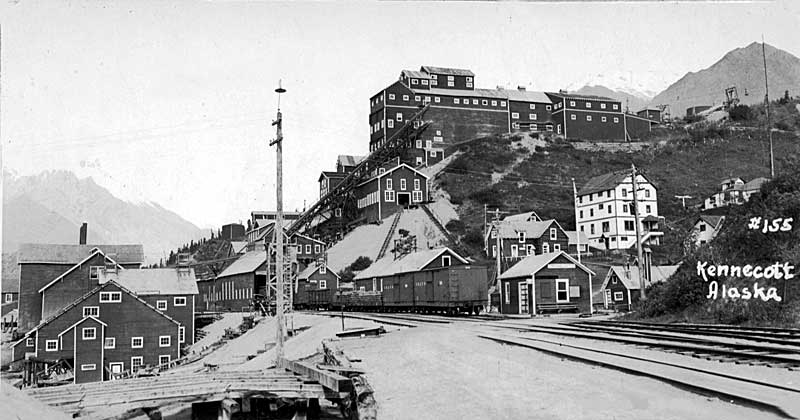
| | |
| |
--Candy Waugaman photo | | |
|
No comments:
Post a Comment